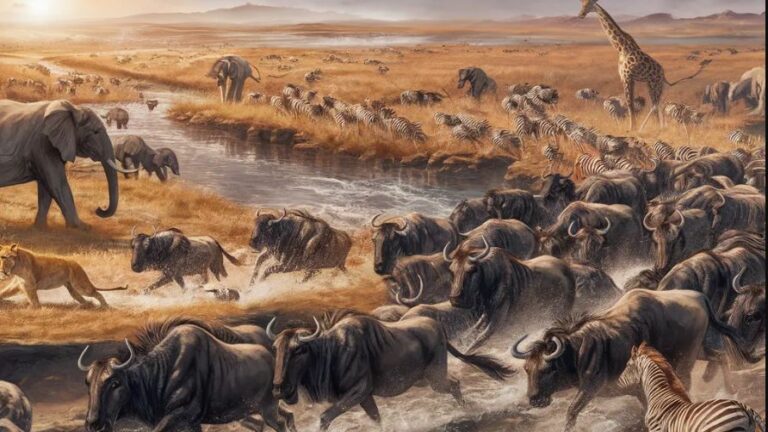The Great Migration, one of the most awe-inspiring natural spectacles on Earth, unfolds across the vast plains of Kenya and Tanzania. This annual journey of millions of wildebeest, zebras, and other herbivores in search of greener pastures is a sight to behold. For travelers seeking an unforgettable wildlife experience, witnessing the Great Migration is a must. In this guide, we’ll delve into the intricacies of the migration and how to best experience it in Kenya and Tanzania.
Understanding the Great Migration:
The Great Migration is a continuous cycle driven by the search for water and grazing land. It typically spans the Serengeti National Park in Tanzania and the Maasai Mara National Reserve in Kenya, covering an area of approximately 30,000 square kilometers. The migration is a testament to the resilience and adaptability of wildlife in East Africa.
The journey begins in the southern Serengeti, where the wildebeest give birth to their young between January and March. This period, known as the calving season, attracts predators like lions and hyenas, creating a dramatic spectacle of survival. As the dry season approaches, usually around May, the herds start migrating northward in search of fresh grass and water sources.
By June, the migrating herds reach the western corridor of the Serengeti, crossing the Grumeti River, which presents another obstacle fraught with danger, especially from crocodiles lying in wait. By July, the herds begin crossing into the Maasai Mara in Kenya, spurred by the promise of lush grasses brought about by the seasonal rains.
August and September mark the peak of the migration in the Maasai Mara, with vast herds dotting the landscape as far as the eye can see. The Mara River crossings during this time are particularly thrilling, as wildebeest and zebras brave swift currents and hungry crocodiles to reach the other side.
As the short rains commence in October, the herds gradually make their way back south, completing the circle of life that has repeated for generations.
Planning Your Great Migration Safari:
To fully immerse yourself in the spectacle of the Great Migration Safari, careful planning is essential. Here are some tips to ensure a memorable experience:
1. Choose the Right Time:
Timing is crucial when planning your safari. To witness the dramatic river crossings in the Maasai Mara, aim for a visit between July and September. However, if you prefer a quieter experience with fewer crowds, consider traveling during the shoulder seasons in June or October.
2. Select Reputable Tour Operators:
Partnering with experienced tour operators who specialize in wildlife safaris ensures a smooth and rewarding experience. Look for operators with knowledgeable guides who understand the nuances of the migration and can offer insightful commentary throughout your journey.
3. Accommodations:
Accommodation options range from luxury lodges to mobile tented camps, each offering a unique perspective on the migration. Consider staying in a camp strategically located near river crossings or prime wildlife viewing areas to maximize your chances of witnessing the action up close.
4. Be Flexible:
Nature operates on its own schedule, and wildlife sightings are never guaranteed. Maintain a flexible itinerary that allows for spontaneous detours and extended stays in areas where the migration is most active.
5. Pack Accordingly:
Essential items for your safari include lightweight clothing, sturdy walking shoes, a wide-brimmed hat, sunscreen, insect repellent, and binoculars for enhanced wildlife viewing.
Experiencing the Great Migration:
Once you’ve arrived in Kenya or Tanzania, prepare to be mesmerized by the sights and sounds of the Great Migration. Here are some key experiences to look forward to:
1. Game Drives:
Embark on exhilarating game drives through the heart of the Serengeti and Maasai Mara, where you’ll encounter vast herds of wildebeest, zebras, gazelles, and their predators in action. Knowledgeable guides will help you navigate the terrain and spot elusive wildlife hiding in the savannah.
2. Balloon Safaris:
For a truly unforgettable perspective, consider booking a hot air balloon safari over the Serengeti or Maasai Mara at sunrise. As you soar above the plains, you’ll witness the breathtaking beauty of the landscape and the sweeping movements of the migrating herds below.
3. Walking Safaris:
Explore the wilderness on foot with guided walking safaris led by experienced rangers. Walking safaris offer a more intimate encounter with the environment, allowing you to appreciate the smaller details often missed from a vehicle.
4. Cultural Encounters:
Take the opportunity to learn about the rich cultural heritage of the Maasai and other indigenous communities living in the vicinity of the national parks. Engage in cultural activities, visit local villages, and gain insight into traditional practices and way of life.
5. Photography Opportunities:
Capture the awe-inspiring moments of the Great Migration through your lens. Whether you’re a seasoned photographer or an amateur enthusiast, the sheer abundance of wildlife and dramatic landscapes provide endless opportunities for stunning photographs.
Conclusion:
Experiencing the Great Migration in Kenya and Tanzania is a once-in-a-lifetime adventure that promises to leave a lasting impression. From the thundering herds of wildebeest to the primal struggle for survival, every moment is a testament to the raw beauty and complexity of nature. By planning your safari thoughtfully and embracing the unpredictability of the wilderness, you’ll embark on a journey of discovery that transcends words and leaves you forever changed. So pack your bags, ready your camera, and prepare to witness one of the greatest spectacles on Earth unfold before your eyes.

